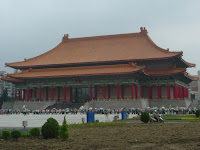A great viral video ad from Quicksilver featuring a new daredevil sport in Denmark.
Dynamite Surfing - Watch
Mindtheft
If I write it down I won't forget it
Monday, March 5, 2007
The Dynamite Surfing Commercial
Saturday, March 3, 2007
The Taiwan Photos - Part 1
Taipei 101 And Other Sights
(Originally posted on SkyscraperCity)
Here are my photos of some of Taipei’s main sightseeing spots. I’ve divided them into five categories: Longshan Temple, The Grand Hotel, Sun Yat-Sen Memorial, Chiang Kai-Shek Memorial and Taipei 101. Enjoy...
Longshan Temple
Established in 1738, Longshan Temple is dedicated to the Buddhist Goddess of mercy, Avalokiteshvara (Guanshiyin), although it’s actually a multidenominational temple and there are another 165 deities who are also worshipped. It’s a great place to watch worshippers offering food to the deities (photo 05), praying (photo 06) and burning incense (photo 07). The ornate gilded woodwork (photos 01-03 and 08) is also worth checking out.
01
02
03
04
05
06
07
08
09
10
The Grand Hotel
Built in 1952, though expanded and transformed over the decades, the Grand Hotel’s amazing traditional-style architecture ensured it became a tourist attraction. Check out the close-ups of its beautiful paintwork (photos 13 and 14), the shot of the guests’ expensive cars (photo 15) and a shot of the local wildlife outside (photo 19).
11
12
13
14
15
16
17
18
19
Sun Yat-Sen Memorial
Revolutionary Sun Yat-Sen is often referred to as the "Father of Modern China" as he established the Republic of China, becoming its first President in 1912. He also founded the Kuomintang political party, which was later driven out of China by the Communists in 1949 and fled to Taiwan. Sun Yat-Sen was succeeded by Chiang Kai-Shek (see below) as leader of the Kuomintang, and Taiwan’s official name (outside of China anyway) of ‘The Republic of China’ has remained.
Check out the striking yellow roof of the Sun Yat-Sen Memorial (photo 21), the giant Sun Yat-Sen statue (photo 23), the immaculately dressed guards with their personal 'groomers’/‘shirt lifters’ (photo 29) and Taiwanese topiary (photo 33), as well as the Matrix-like Chinese character inscriptions (photos 24 and 25), records of Taiwan’s Japanese colonial past (photo 27) and the ‘helpful’ labeling of artifacts (photo 26) in the memorial’s museum:
20
21
22
23
24
25
26
27
28
29
30
31
32
33
Chiang Kai-Shek Memorial
The 70m-high Memorial Hall was completed in 1980, five years after the death of Taiwan’s first President, Chiang Kai-Shek. The white stonework and dark blue roof (the same colour as the flag of the Kuomintang) are quite striking, and the memorial is complemented by a huge plaza (photo 34), a matching white and purple gate at the opposite end of the plaza (photo 40), and the twin National Theater and National Concert Hall buildings (photos 38&39). Like the Sun Yat-Sen Memorial there’s also an impressive highly-choreographed changing of the guards ceremony every hour (photo 36), and the plaza also appears to serve as a meeting place for political rallies and protests (photo 41).
34
35
36
37
38
39
40
41
Taipei 101
The world’s tallest building was completed in 2003, and is 508m tall with 101 storeys. Some random facts from Emporis.com:
-This will be one of the few buildings in the world equipped with double-deck elevators. Each elevator is designed with an aerodynamic body, pressurization and emergency braking systems, and the world's first triple-stage anti-overshooting system. The cost for each elevator is over $US 2 million.
-The tower's design and specifications are all based on the "8", a lucky number in traditional Chinese culture. This kind of "8-design" was also widely used in the Jin Mao Tower in Shanghai.
-The Taiwan Stock Exchange will rent 7 floors in the building.
-The shopping mall, Taipei 101 mall, officially opened in November 13th, 2003.
And some from Taiwan Fun:
-Taipei 101 has the world's fastest elevators. These can transport passengers to the 89th-floor observatory in a mere 39 seconds. Each one of these 1000-meter-per-minute elevators cost more than NT$68 million.
-To prevent the building from swaying during typhoons or earthquakes, an 800-ton, US$4 million, ball-shaped damper is used to dissipate lateral vibration to a spring system underneath. For the first time in architectural history, the damping system is is not hidden, but part of the building's design. This world's largest damper ball has a diameter of 5.5 meters and is visible from the 88th and 89th floors.
Check out advertising at the base of Taipei 101 (photo 43), a sculpture outside (photo 44), shots from inside the mall (photos 49-51), the ball-shaped damper (photo 52), views from the 89th floor observatory (photos 53-60) and a night view of the tower (photo 61):
42
43
44
45
46
47
48
49
50
51
52
53
54
55
56
57
58
59
60
61








